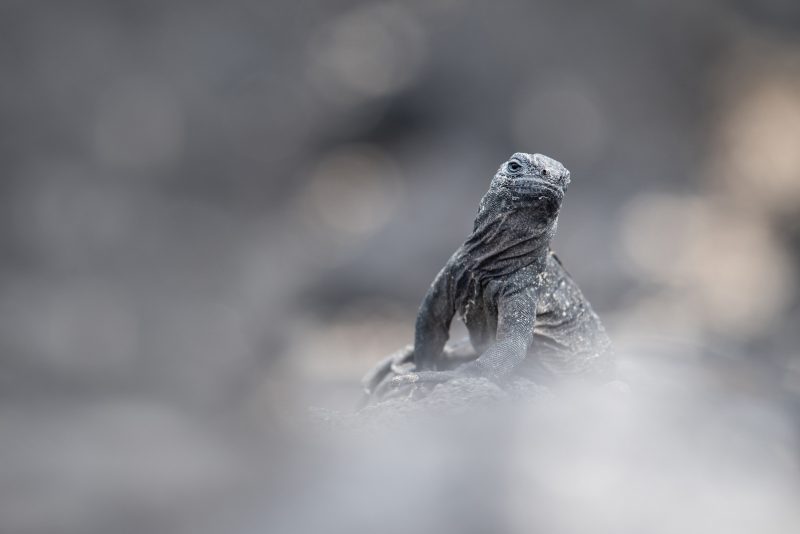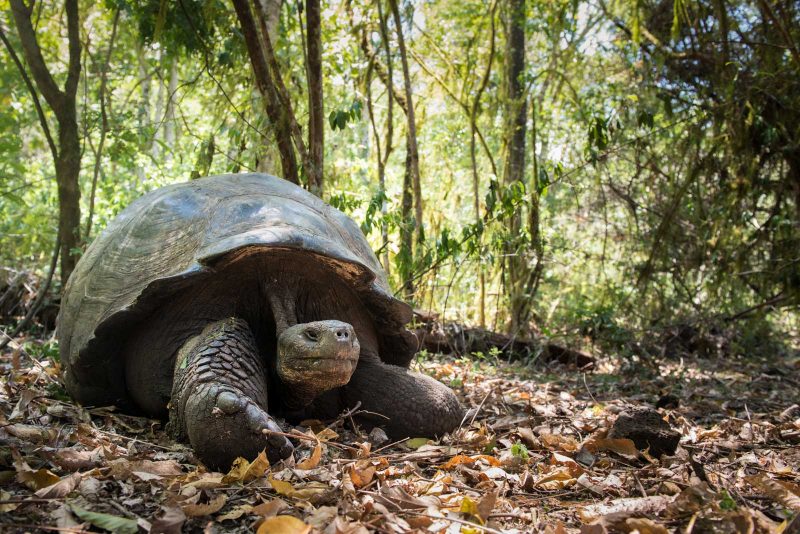How to Photograph Wildlife in the Galapagos

The Galapagos Islands – an archipelago like nowhere else in the world, with its bustling terrestrial and marine life, is on every wildlife photographer’s bucket list. Its isolation more than a 1000km off the coast of Ecuador, unique location on the equator, and being in the middle of the Pacific have made this volcanic complex of islands a unique breeding ground for some of the rarest and most charismatic animals.
In the Galapagos, species have developed unique traits and adapted perfectly to survive these harsh environments. This living laboratory, which inspired Charles Darwin’s theory of evolution, is also at the mercy of three ocean currents. It creates nutrient rich waters, which are home to an array of wonderfully diverse marine creatures that make for unforgettable dives.


When you think of the Galapagos Islands, you are probably picturing gentle giant tortoises, diving marine lizards, flightless cormorants, pink iguanas, and massive schools of hammerhead sharks.
If you are familiar with the latest Planet Earth series from the BBC, you would of course remember the thrilling sequence of emerging baby iguanas being chased by an army of racer snakes. Or if you are the type of photographer and naturalist that I am, always on the lookout for the weirdest and most unusual behaviours, you might think of the vampire finch and would love nothing more but to photograph it.
However, when traveling to the Galapagos Islands it is important to do your research, manage your expectations, and know that some of these sites are extremely remote and only accessible on a live-aboard. Some areas are even restricted to scientists only. Don’t worry if you are visiting the Galapagos on a budget and plan on stopping at a couple of islands, as there are still plenty of amazing encounters and photographic opportunities!
Here is some useful information on what to expect and bring with you to the Galapagos Islands to make the most of your bucket list experience.
Follow the rules and manage expectations
One of the biggest appeals for wildlife photographers coming to the Galapagos Islands is the abundance of its wildlife and its fearless nature. Because of a lack of land predators, animals here don’t associate humans as being a threat and are extremely tame.
This is a totally unique experience and amazing to witness. However, it is important to remember that these are still wild animals – just because you can get close does not mean you should take liberties.
As a visitor of a World Heritage site, and National Park, you are expected to behave responsibly and treat the fauna and flora with respect. Beyond the common sense rules of no touching or feeding the animals, and leaving no trace behind you, the Galapagos National Park Directorate (GNPD) has had to establish strict rules to limit the impact of the thousands of visitors for ethical and conservation reasons.
Some of the main rules that you need to consider as a photographer are:
- you must stay 2 metres (6 feet) away from all the wildlife
- the use of flash is not permitted
- you must stick to the footpaths and only visit official visitors sites, most of which require that you be accompanied by an authorized guide.
As a wildlife photographer, you are probably used to wandering around on your own so this might feel a bit restrictive, but remember that by respecting these rules you are playing your part in conserving the islands and also helping the local economy. Finally, commercial photography or video must be authorised by the GNPD.
If you’re not taking part in an expensive multi-day cruise that will take you all around the islands, you will probably not see some of the species that are unique or only breed on some of the islands. For example, the flightless cormorant on Isabela, or waved albatross on Española.
However, you will still be able to tick off the “Galapagos Five”. There are plenty of marine iguanas, sea lions, and giant tortoises on Santa Cruz alone. Day-tours to South Plaza island allows you to see terrestrial iguanas, but you might even catch a glimpse of them in Baltra on your way in or out to the airport. You can also island hop in Isabela for flamingos, see penguins in Floreana, and nesting blue footed boobies and frigate birds in North Seymour!
The same can be said with diving. Some of the best sites, where you can see hundreds of hammerheads and whale sharks, are far off shore near Darwin and Wolf, and therefore not accessible from Puerto Ayora. However, all dive sites in the central islands are amazing, and if you are looking for the ultimate shark experience you should try Gordon Rocks and Kickers rock.
Read more: 7 Tips for Beginners in Underwater Photography
Beware of the heavy currents though, which is exactly what attracts all these pelagic species. Make sure that you are qualified and experienced enough to take on some of the most difficult dive sites, like Gordon Rocks, referred to as the washing machine. Pick a dive site that is compatible with your diving abilities, especially if you are planning on taking photos.
Pack light and versatile equipment
As a wildlife photographer, you always want to be prepared and have all the lenses and accessories for all situations. Whilst you want to make the most of every single wildlife encounter and don’t want to miss any opportunity, don’t underestimate the climate and roughness of the terrain.
When you are spending all day hiking, snorkelling, and crouching up and down to get those low shots under the equatorial sun, it is bound to take a toll on your body. Make sure you have a light – yet versatile – setup to maximise your experiences without exhausting yourself. You don’t want to carry cumbersome bags whilst scrambling over the extremely slippery and equally sharp lava rock. It can be very hazardous, and it’s easy to injure yourself.
I would recommend bringing a wide-angle lens (24-70mm or 16-35mm), a telephoto zoom lens (70-200mm or 100-400mm), or a 300mm prime and a teleconverter. You’ll definitely want a fast lens when capturing birds in flight. For terrestrial subjects, a 300mm lens will be more than enough – but having a teleconverter with you can be handy as you need to stick to the footpaths.
Because of the remoteness of the islands, photography equipment and services available are very limited and expensive. Don’t expect that you will be able to get your gear repaired or your sensor cleaned.
Make sure you have plenty of batteries, spare SD cards and protective UV/Polarised filters so your precious glass is always out of danger. Have a cleaning kit at hand to deal with sand and water droplets.
Be very careful with sand whilst changing lenses, particularly if you are using a mirrorless camera. Bring a few dry bags just in case. If you have the ability, a back up camera body is always useful.
Even if you are not a diver, there will be plenty of opportunities for marine photography whilst snorkelling, so bring an underwater housing if you can. I have had some of the best snorkeling experiences in the Galapagos at Santa Cruz’s Tortuga Bay and Playa de la Estacion: swimming with eagle rays, juvenile sharks, and Galapagos sea turtles.
Take your time with your composition
It can be overwhelming to be a wildlife photographer in the Galapagos, with an instinctual reflex to shoot everything and anything. As a tourist, you might only be allowed a couple of hours in one site – but as the animals are very tame, they are not going anywhere!
Take the time to observe their behaviour, take in the environment, and shoot with purpose. Really think about what story you want to tell. Anyone can take a quick wildlife photograph in the Galapagos, but what will make your images stand out is not just your subject, but your composition.
Remember the rule of thirds, get at eye level with the animals, and try to look for that eye contact. Getting low will make your subject stand out from a distracting background.
For portraits, experiment with shallow depths of field and think about ways of blurring your foreground to draw immediate attention to your subject.
Finally, I would recommend picking a particular species to focus on during your trip. This will allow you to try and cover all angles with different lenses, under different lighting, experiment with different styles and capture all the remarkable attributes. Focusing on marine iguanas or sea lions, for example, is a great place to start as they are pretty much everywhere and can be found on most islands.
Work with the light
The light in the equator can be harsh fairly early in the morning, so make sure that you get the most of the golden hour at every sunrise and sunset. Pay attention to the direction of the light and try silhouetting subjects like marine iguanas or blue footed boobies against the orange sky.
For most of the day, the light can be jarring on any subject against the black volcanic rocks, but regardless you won’t want to put your camera away. Try spotlighting your subject and underexposing the background so your subject is highlighted. Bring some neutral density filters so you can play with the motion of the waves against relatively immobile species like the sally lightfoot crabs.
Final tips
As temperatures rise, the wildlife will become less active. However, if you find a snorkelling spot near a marine iguana colony, you’ll have the best chance at seeing them swim around midday.
Make sure you take a rest from your long lens and use your wide-angle lens too. Practise your landscape photography as the scenery is stunning. Don’t forget to place your subjects within their habitat and nail those environmental shots. Consider the background to tell a wider story, and stick to the rules of thirds.
Equally, don’t put your camera down at night. The Galapagos offers plenty of astrophotography opportunities: on a clear night the Milky Way looks spectacular. Some of the wildlife will still be active, having become accustomed to the city lights; some species use it to their advantage. For instance, lava herons hunt for insects under lamp posts as they’re attracted by the light.
In conclusion
Regardless of the time of year you go, you are going to have an amazing time in the Galapagos. However, do your research so you know exactly what to expect or to ensure you plan your trip during the breeding season of a particular species you might wish to photograph.
You will definitely want to photograph adorable sea lion pups interacting with their mothers. As well as this, you might see the surprising Christmas colours of marine iguanas during their mating season, or the comical courtship dances of the blue footed boobies.
At the end of the day, wildlife photography is all about capturing amazing behaviour; so take your time, be observant, and don’t forget to enjoy it!














